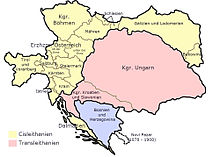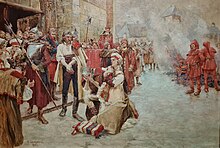Croatia in national association with Hungary


With the signing of the historically controversial Pacta conventa in 1102 until the end of the Austro-Hungarian monarchy in 1918, Croatia was part of the state union with Hungary . Due to the problematic source situation, it cannot be said with certainty whether this was a personal union while maintaining Croatian statehood or a real union with the loss or partial loss of Croatian sovereignty to Hungary. Croatia had a special status that was repeatedly adapted in the countries of the Hungarian crown . The joint Hungarian-Croatian king was at the head of the Croatian state authority . Its rights were restricted by the Sabor (Croatian assembly of estates ). The Ban (Croatian viceroy) held the supreme executive power and convened the Sabor, in which he also chaired.
State Association
The Croatian King Dmitar Zvonimir (1075-1089), who was married to the Hungarian princess Jelena the Beautiful , died without a successor under circumstances that were not beyond doubt. The Croatian ruling dynasty Trpimirović was thus extinct. There were throne disputes in the country, as a result of which (1091) the Hungarian King Ladislaus took inland Croatia through subjugation agreements with the Croatian cantons ( Croat . "Župan" ).

After Ladislaus' death, Croatia tried to evade possible Hungarian rule, but was again subjugated in 1097 by King Koloman - like Ladislaus from the Hungarian royal dynasty of the Arpades . The Hungarian king was related to the Croatian ruling dynasty. Koloman concluded a treaty with the twelve most powerful cantons of Croatia, according to which they should be under the sovereignty of Hungary and united as a state association with this kingdom, but should be independent in all internal matters. He was the so-called " Pacta conventa " in personal union "King of Croatia" .
The administration of Croatia was taken over by Ban , a Croatian representative. This state association lasted until 1526. State insignia and attributes of the Croatian kingdom remained.
Since Vladislav II. (1490–1516) the Hungarian king title “rex Dalmatiae et Croatiae” (King of Dalmatia and Croatia) was accompanied by “et Slavoniae” (and Slavonia ). As a result of the Turkish conquest, part of Slavonia was later (see above) separated as "Croatia" from "Slavonia" in the narrower sense ( Virovitica , Požega and Sirmia ). The Turkish rule largely devoured these areas. Under Emperor Leopold I , all of Slavonia was conquered and ceded to the Habsburg Empire in the Karlowitz Peace of 1699 .
In the 15th century, almost all of Croatia was conquered by the Ottomans and shrank to a small strip between the Adriatic and the Drava. In 1527 the Croatian Sabor elected Ferdinand I of Habsburg to be their king in Cetin Castle “completely freely and without outside influence” . In doing so, they hoped for more effective military help in defending Croatia against the advancing Ottomans. Ferdinand I collected soldiers and made funds available for defense purposes. Since then, with short interruptions, Croatia remained united with the Kingdom of Hungary under the rule of the Habsburgs until 1918 .
Autonomy of Croatia
With the exception of a short time after the Treaty of Karlowitz concluded with the Turks in 1699, Croatia was never a Hungarian province. It always had an autonomous character, although over the course of 700 years the degree of this autonomy gradually decreased. This autonomy was based on a civil administration under a royal banu until 1848 . He was of Croatian nationality and had extensive powers. Its administration was largely controlled by the Croatian parliament Sabor . But the legal decisions that this parliament passed had to be in accordance with Hungarian laws.
Nevertheless, two of the most important state acts in Croatian modern history - the election of the Habsburg dynasty in 1527 and the recognition of the Pragmatic Sanction in 1712 - were free decisions of the Croatian estates and an expression of the autonomous position of Croatia as a historical-political individuality in its relationship with Hungary and to the kingdom.
Turkish Wars
By the end of the 15th century, the Ottomans had conquered all of Serbia , Bosnia , Herzegovina , Zeta , Morea and Albania . The hurried crusade army of the Hungarian King Sigismund was defeated by the Turks in 1396 at the Battle of Nicopolis . The only buffer between the Ottomans and the Christian West was the barely defended Croatian territory.
Christian Europe turned to the Pope for help and demanded an "expeditio generalis" against the " unbelievers " . Bosnia came under Ottoman rule in 1463 and after the heavy defeat on the Krbava field in 1493 the resistance of the Croatian nobility was broken. The Turks conquered the areas south of Gvozd and eastern Slavonia . Croatia shrank to a narrow strip between the Danube and the Adriatic Sea. The subsequent migration of the Croatians to the north changed the population composition of the coastal areas. Only the Republic of Ragusa had a certain freedom, as the city had freed itself from the rule of Venice in 1358 and paid annual tribute to the Turkish sultan.
The Ottoman units advanced until shortly before Karlovac , and after the Christian army was completely wiped out by the Turks in the Battle of Mohács in 1526, the situation deteriorated for the rest of Europe as well.
The result of the defense efforts in the 15th century were 30 military campaigns and seventy cities destroyed. The Turkish Wars also shaped almost the entire 16th century. The Bane Nikola Šubić Zrinski , Ivan Drašković von Trakošćan and Nikolaus Frankopan , who are considered Croatian national heroes, achieved particularly outstanding military successes against the Ottoman conquerors .

In 1519 Pope Leo X called the Croats " Antemurale Christianitatis " (Bulwark of Christianity) . A decade later, Croatia came into the protective favor of the Habsburgs. In 1527 the Croatian nobility recognized the Habsburg Ferdinand I as king of Croatia and Hungary, which is considered in return for leading the defense against the Turks. Croatia was granted the same rights as the Hungarian royal family.
The growing loss of Croatian land to the Turks led to the establishment of a new Hungarian Croatia by incorporating the three (previously Slavonian) counties Zagreb , Varaždin and Križevci into the same. Orthodox believers also settled there who did not want to live under the Ottoman occupation. In 1592 the Turks conquered the fortress Bihać in Croatia, which, along with some surrounding towns, has remained under Turkish rule ever since. During the hundred-year Croatian-Ottoman War between 1493 and 1593, large parts of Croatia were devastated by minor advances and looting by regular and irregular Ottoman units.
The Reformation also found its way into Croatia in the 16th century , but was violently suppressed from 1607 to 1610. At the beginning of the 17th century, Croatia, which was completely devastated and economically ruined, could hardly raise the funds for the maintenance of the military border ( Austria-Hungary defensive belt ).
In the course of the 17th century the Turks suffered defeats, so that the Treaty of Karlowitz in 1699 brought freedom from the Turks for Hungary and Western Slavonia. In the treaty the Sultan ceded all land beyond the Una to Austrian Croatia.
The defeat of the Turks at Vienna in 1683 and the ensuing liberation of the Croatian territories from Turkish power finally brought peace to Croatia after the endless, almost uninterrupted wars against the Turks for centuries.
Dalmatia under Venetian rule
Ladislaus von Anjou sold Dalmatia to Venice for 100,000 ducats in 1409 .
The Venetians were then able to expand their sphere of influence even further and until 1797 ruled over most of Istria in addition to Dalmatia .
Venice made great profits through its tax and customs policy and massive clearing of the forests in Dalmatia, without being interested in any serious progress. The city of Venice is largely built on logs from Dalmatia, the Venetian fleet also devoured vast amounts of wood. The partly vegetationless karst areas of Istria and Dalmatia were largely created by the overexploitation of the Venetians.
These areas lagged behind Venice and most other Italian states in their development, mainly because of their economic subjugation.
The Venetians granted the occupied Croatian cities a certain degree of autonomy , but only Venetian nobles were allowed to provide heads of the cities. Under Venetian rule, an anti-Croatian policy was also conducted for the first time : Citizens of the city of Zadar , for example, were forbidden to marry Croats. Only the Catholic faith connected the Croats with the Venetians. The oligarchic and colonialist policy of Venice led to resistance and uprisings. The largest uprising took place on the island of Hvar in 1510 under the leadership of Matija Inavnić . The Uskoks fought the Venetians on land with guerrilla tactics, at sea with piracy .
Dubrovnik (Ragusa) alone has lost none of its glamor over the centuries thanks to its untouched autonomy , its politics and diplomacy , its trade, its seafaring and its culture .
In the 16th century, Dubrovnik's merchant fleet was the third largest in the Mediterranean and consisted of over 300 ships.
Only the establishment of the short-lived Illyrian provinces under Napoléon Bonaparte ended the rule of Venice over most of the Croatian coastal area.
literature
- Stanko Guldescu: The Croatian-Slavonian Kingdom. 1526-1792 . The Hague 1970.
- John van Antwerp Fine: When ethnicity did not matter in the Balkans. A study of identity in pre-nationalist Croatia, Dalmatia, and Slavonia in the medieval and early-modern periods . Ann Arbor, Michigan 2006.
- Claus Heinrich Gattermann: Croatia - Two thousand years of history on the Adriatic . Georg Olms Verlag, Hildesheim / Zurich / New York 2011, ISBN 978-3-487-14706-2 .
Individual evidence
- ^ Konrad Clewing, Oliver Jens Schmitt: Geschichte Südosteuropas. Verlag Friedrich Pustet, Regensburg 2012, p. 153.
